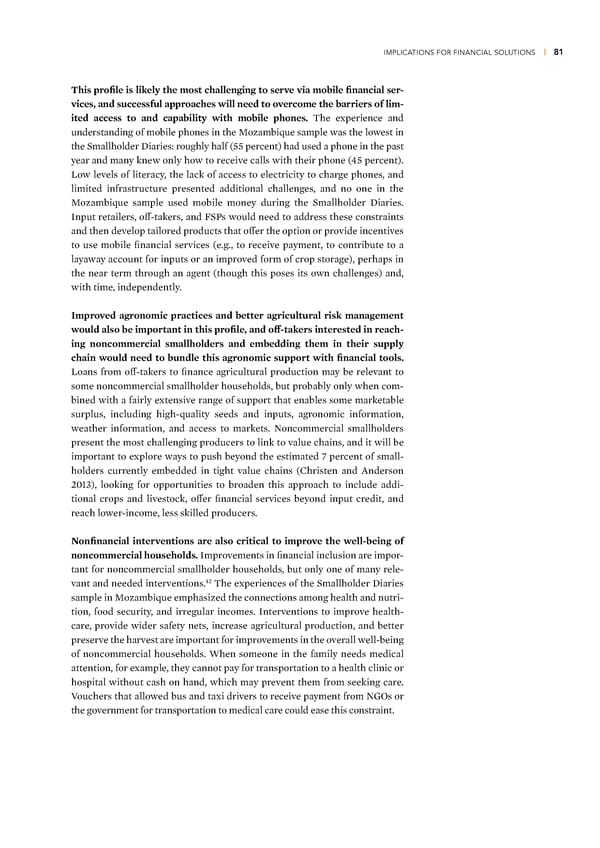IMPLICATIONS FOR FINANCIAL SOLUTIONS | 81 his profile is liƒely the most challenging to sere ia mobile financial ser- ices, and successful approaches will need to oercome the barriers of lim- ited access to and capability with mobile phones Œhe experience and understanding of mobile phones in the –o—ambiue sample was the lowest in the Smallholder ‰iaries roughly half (”” percent) had used a phone in the past year and many new only how to receive calls with their phone (“” percent) ƒow levels of literacy, the lac of access to electricity to charge phones, and limited infrastructure presented additional challenges, and no one in the –o—ambiue sample used mobile money during the Smallholder ‰iaries €nput retailers, off-taers, and Ss would need to address these constraints and then develop tailored products that offer the option or provide incentives to use mobile financial services (eg, to receive payment, to contribute to a layaway account for inputs or an improved form of crop storage), perhaps in the near term through an agent (though this poses its own challenges) and, with time, independently Šmproed agronomic practices and better agricultural risƒ management would also be important in this profile, and off-taƒers interested in reach- ing noncommercial smallholders and embedding them in their supply chain would need to bundle this agronomic support with financial tools ƒoans from off-taers to finance agricultural production may be relevant to some noncommercial smallholder households, but probably only when com- bined with a fairly extensive range of support that enables some maretable surplus, including high-uality seeds and inputs, agronomic information, weather information, and access to marets ˜oncommercial smallholders present the most challenging producers to lin to value chains, and it will be important to explore ways to push beyond the estimated • percent of small- holders currently embedded in tight value chains (†hristen and ˆnderson ‘’…Ÿ), looing for opportunities to broaden this approach to include addi- tional crops and livestoc, offer financial services beyond input credit, and reach lower-income, less silled producers •onfinancial interentions are also critical to improe the well-being of noncommercial households €mprovements in financial inclusion are impor- tant for noncommercial smallholder households, but only one of many rele- “‘ vant and needed interventions Œhe experiences of the Smallholder ‰iaries sample in –o—ambiue emphasi—ed the connections among health and nutri- tion, food security, and irregular incomes €nterventions to improve health- care, provide wider safety nets, increase agricultural production, and better preserve the harvest are important for improvements in the overall well-being of noncommercial households ™hen someone in the family needs medical attention, for example, they cannot pay for transportation to a health clinic or hospital without cash on hand, which may prevent them from seeing care §ouchers that allowed bus and taxi drivers to receive payment from ˜‡¦s or the government for transportation to medical care could ease this constraint
 Financial Diaries with Smallholder Families Page 99 Page 101
Financial Diaries with Smallholder Families Page 99 Page 101